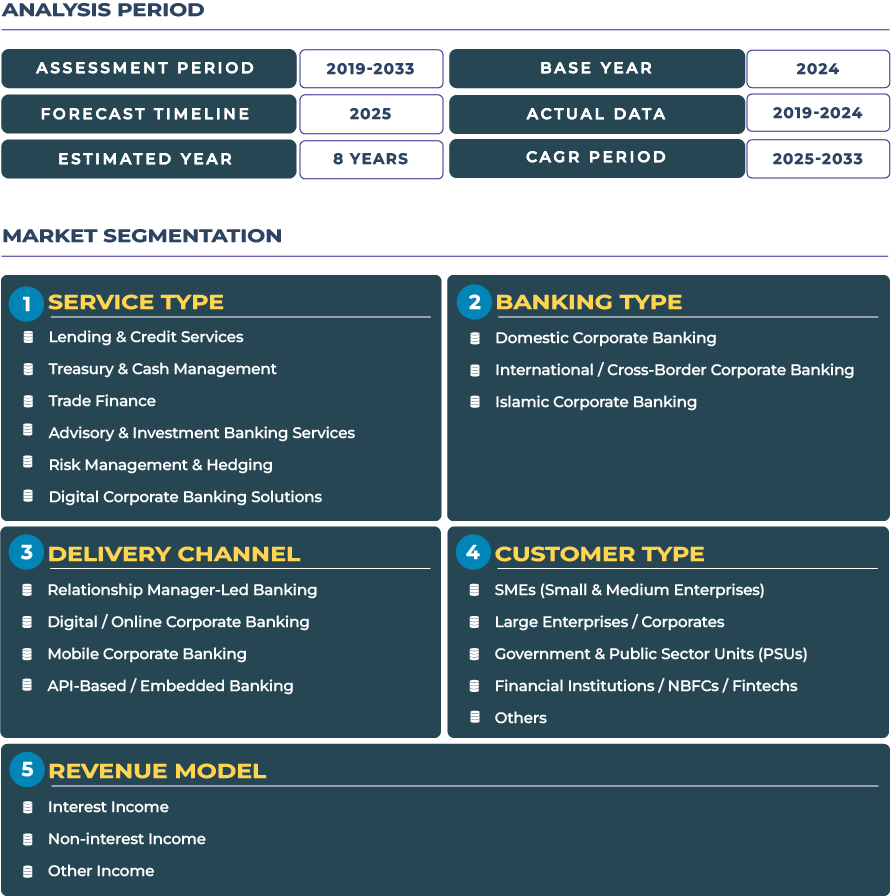Peru Corporate Banking Market Outlook: Empowering Export-Led Growth Through Trade Finance and Digital Transformation
Peru corporate banking market is entering a transformative phase as local and international banks strengthen their trade finance and export lending frameworks to support the country’s export-oriented economy. With key sectors such as mining, agriculture, and manufacturing fueling external trade, banks are increasingly focusing on building digital-first trade ecosystems that empower SMEs to access global markets. The Peru corporate banking market is estimated at USD 12.0 billion in 2025 and projected to reach USD 15.1 billion by 2033, reflecting a CAGR of 3.0% between 2025 and 2033, according to DataCube Research.
Note:* The market size refers to the total revenue generated by banks through interest income, non-interest income, and other ancillary sources.
This steady expansion is driven by the government’s emphasis on financial inclusion, the ongoing diversification of exports beyond mining, and the growing role of fintech-enabled trade financing tools. Corporate banks are deploying advanced treasury and cash management solutions to optimize liquidity for exporters while also expanding structured lending products for supply chain participants. Initiatives from the Superintendencia de Banca, Seguros y AFP (SBS) have encouraged digital banking adoption, improving financial access for small and medium enterprises in trade-heavy regions such as Arequipa, Lima, and Trujillo.
Amid a resilient macroeconomic environment, Peru corporate banking industry is adapting to shifting market dynamics through a blend of digitization, credit innovation, and export facilitation. The country’s robust mining and agriculture exports have created long-term opportunities for specialized trade finance instruments, positioning corporate banks as vital enablers of Peru’s export competitiveness.
Drivers & Restraints: Commodity Exports, SME Integration, and the Challenge of Concentrated Banking
A key growth driver for the Peru corporate banking sector lies in the increasing need for project and trade finance solutions among mining and commodities corporates. Mining contributes nearly 10% to Peru’s GDP, and the sector’s dependence on capital-intensive operations has led to strong demand for syndicated loans, pre-export financing, and structured trade instruments. Exporters are seeking liquidity optimization tools and hedging services to manage price volatility and foreign exchange exposure, particularly as the Peruvian sol fluctuates against the U.S. dollar.
In parallel, SMEs within mining supply chains are increasingly accessing working capital loans and supplier finance platforms provided by major banks. This segment is witnessing strong activity as banks like BBVA Peru and Banco de Crédito del Perú (BCP) expand customized digital credit lines for smaller enterprises supporting large export projects. The growing focus on digital corporate banking ecosystems is facilitating efficient fund flow management and improved payment reconciliation for exporters.
However, market growth is tempered by structural constraints. The high dependence on commodity cycles exposes the banking system to price volatility in copper and gold, which dominate Peru’s exports. Additionally, a relatively concentrated banking landscape, with a few dominant players, limits competitive innovation and price differentiation in lending services. Geographic challenges also restrict branchless banking penetration across remote Andean and Amazon regions, slowing down corporate outreach. Despite these constraints, the sector’s long-term trajectory remains optimistic, supported by technological modernization and greater integration with regional trade frameworks.
Trends & Opportunities: From Green Mining Finance to Digital Supplier Ecosystems
Peru corporate banking industry is evolving in line with major global shifts in trade finance and sustainability. A standout trend is the expansion of commodity trade finance in response to rising global demand for lithium, copper, and agricultural exports. Banks are increasingly embedding ESG-linked financing models that encourage responsible mining and export practices. This shift toward green mining capex financing aligns with Peru’s environmental goals and international investor expectations.
At the same time, the adoption of digital supplier finance solutions is gaining momentum across mining corridors in southern Peru. Financial institutions are building API-integrated platforms that connect suppliers, contractors, and exporters in real-time, enhancing transparency and credit efficiency across the value chain. In cities like Lima and Arequipa, banks are rolling out blockchain-supported trade documentation systems to accelerate approval cycles and reduce fraud risks.
The country’s emphasis on financial digitization through Peru’s Ministry of Economy and Finance initiatives is unlocking further opportunities for corporate lenders. These include green project financing, ESG-linked export loans, and commodity receivable discounting solutions. As Peru strengthens trade ties with markets in Asia and Europe, corporate banks are expected to enhance their cross-border liquidity products and digital FX management platforms, creating new avenues for growth.
Competitive Landscape: Strategic Digital Partnerships and Green Lending Initiatives Redefining Competition
The Peru corporate banking ecosystem is led by established institutions such as Banco de Crédito del Perú (BCP), BBVA Peru, Scotiabank, and Interbank, alongside international players offering specialized trade finance services. BCP, for example, has recently expanded its trade finance portfolio to support small exporters with faster loan approvals and electronic documentation capabilities. Meanwhile, BBVA Peru has integrated digital treasury management and supplier finance solutions targeting mining SMEs, enhancing its market share in the corporate segment.
Scotiabank has launched a green financing framework to promote ESG-based lending in the mining and infrastructure sectors, positioning itself as a frontrunner in sustainable banking. Interbank continues to strengthen its cross-border payment network, leveraging partnerships with global fintechs to optimize treasury operations for corporate clients. Across the board, Peruvian banks are diversifying revenue streams by embedding digital risk management and AI-supported analytics into trade and lending operations, further professionalizing the corporate banking landscape.
These developments underscore the growing importance of technology, sustainability, and financial agility as competitive differentiators in Peru’s evolving corporate banking market. As banks enhance digital platforms and ESG-aligned credit products, the sector is poised to play a crucial role in supporting Peru’s export resilience and economic stability.







